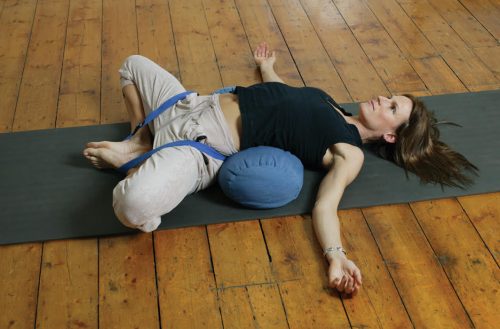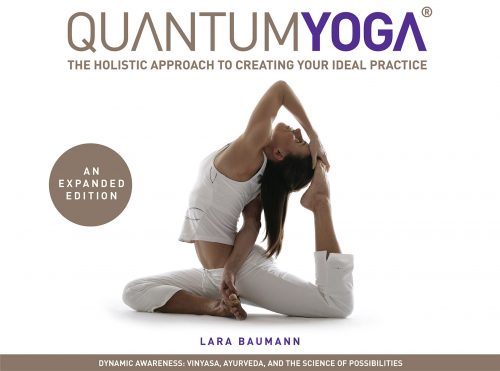THE HOLISTIC APPROACH TO CREATING YOUR IDEAL PRACTICE
New, expanded edition.
Dynamic Awareness: Vinyasa, Ayurveda, and the Science of Possibilities
The book “Quantum Yoga, The Holistic Approach to Creating Your Ideal Practice” is a guide to individualized dynamic self-practice. It consists of two parts. One gives an overview of the yoga tradition, its meaning, history and current forms. It also outlines the basic principles of Ayurveda, yoga’s healing sister-science, as well as explaining key insights in Quantum Physics, both of which inform Quantum Yoga’s unique approach. The second part represents a practical guide to constructing one’s ideal sequence. First the Quantum Assessment Methods are described. The choosing of a theme and/or peak pose is explained, as well as how to sustain the flow and link asanas (postures) in novel ways. Next, the Quantum Grouping & Sequencing Laws are fully outlined, with photos and detailed descriptions to add clarity. The three Basic Quantum sequences are presented in their entirety with fully illustrated charts, which serve the practitioner as sample vinyasa (breath-synchronised movement) sequences, for the regulation of each of the three Ayurvedic doshas (biological constitutions) in turn.
Additional practice of pranayama (breathing exercises), restoratives and menstrual alternatives are also presented. Finally, the reader is given inspiring practical advice on how to get started. It shows you in case studies how physical and emotional impediments are integrated and then skilfully overcome by embracing the Ayurvedic holistic approach of body-mind type recognition and applying this to Quantum Yoga practice. It also includes an Introduction, a section on Pranayama, Menstrual Practice and Drishti. This book is all you will require to establish an effective, fun and sacred practice that is perfect for you!
 We all move our bodies consciously at some point or other, but how often do we consciously exercise our way of breathing? Although breathing exercises look easier to perform than the average yoga posture, beware! In pranayama, we are dealing with the very essence of life and such a practice should be approached with great care. Our breath has a considerable impact on our health, psychological disposition, and state of mind. The word pranayama means both control (yama) and extension (ayama) of prana (vital life force). Hence the word indicates the ability to withhold the breath, as well as the capacity to expand one’s intake of breath through the lungs, hereby maximizing the assimilation of prana. The three essential building blocks of pranayama are: inhalation (puraka), exhalation (rechaka), and retention (kumbhaka). The latter can be further divided into antara kumbhaka (inhalation retention) and bhaya (or bahir) kumbhaka (exhalation retention). Out of these an endless array of exercises can be constructed that have distinctly varying effects. In this video I will introduce you to some of the basic pranayamas or breathing exercises. Our tendency to shallow breathe, especially when we find ourselves in stressful situations, means that we are not exploiting our true energetic capacity, actually when we most need it! The volume of our tidal breath lags well behind our vital capacity. When breathing normally, the tidal air is only very slowly exchanged, so there is always a certain measure of “stale” air in our lungs. Through regular practice of pranayama, the body has access to more oxygen-rich fresh air. It is no wonder therefore, that it leads to higher levels of vitality and joy. If you love asana practice, watch how it improves once you also begin doing specific pranayama exercises regularly.
We all move our bodies consciously at some point or other, but how often do we consciously exercise our way of breathing? Although breathing exercises look easier to perform than the average yoga posture, beware! In pranayama, we are dealing with the very essence of life and such a practice should be approached with great care. Our breath has a considerable impact on our health, psychological disposition, and state of mind. The word pranayama means both control (yama) and extension (ayama) of prana (vital life force). Hence the word indicates the ability to withhold the breath, as well as the capacity to expand one’s intake of breath through the lungs, hereby maximizing the assimilation of prana. The three essential building blocks of pranayama are: inhalation (puraka), exhalation (rechaka), and retention (kumbhaka). The latter can be further divided into antara kumbhaka (inhalation retention) and bhaya (or bahir) kumbhaka (exhalation retention). Out of these an endless array of exercises can be constructed that have distinctly varying effects. In this video I will introduce you to some of the basic pranayamas or breathing exercises. Our tendency to shallow breathe, especially when we find ourselves in stressful situations, means that we are not exploiting our true energetic capacity, actually when we most need it! The volume of our tidal breath lags well behind our vital capacity. When breathing normally, the tidal air is only very slowly exchanged, so there is always a certain measure of “stale” air in our lungs. Through regular practice of pranayama, the body has access to more oxygen-rich fresh air. It is no wonder therefore, that it leads to higher levels of vitality and joy. If you love asana practice, watch how it improves once you also begin doing specific pranayama exercises regularly. This video will provide women with a clear explanation of the two postures most beneficial during menstruation. Particularly if there is pain from cramps and general discomfort, relaxing into these asana will provide great relief and prepare the yogini for a more dynamic practice after her menses. The moon days are a time when apana vayu, the eliminatory “wind” needs to be supported, allowing for an easy shedding of that which the body no longer requires. As a general restorative practice, especially where pitta-regulation, i.e. cooling, soothing and balancing is needed, these poses are also very effective.
This video will provide women with a clear explanation of the two postures most beneficial during menstruation. Particularly if there is pain from cramps and general discomfort, relaxing into these asana will provide great relief and prepare the yogini for a more dynamic practice after her menses. The moon days are a time when apana vayu, the eliminatory “wind” needs to be supported, allowing for an easy shedding of that which the body no longer requires. As a general restorative practice, especially where pitta-regulation, i.e. cooling, soothing and balancing is needed, these poses are also very effective.

